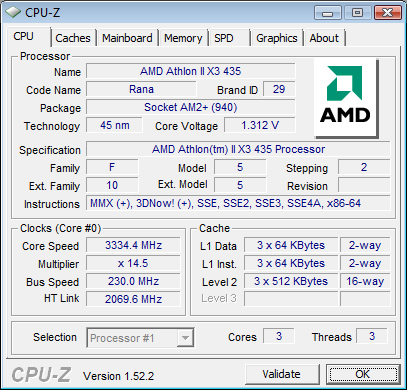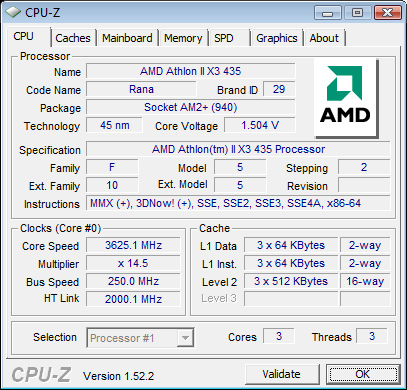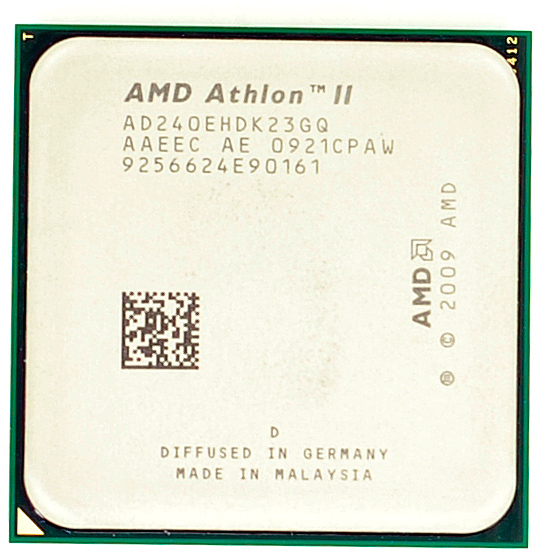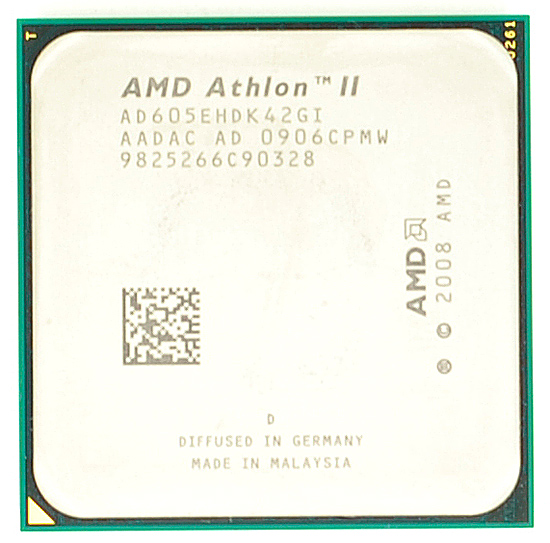AMD's Athlon II X3 435 & New Energy Efficient CPUs: Killing Intel Below $90
by Anand Lal Shimpi on October 20, 2009 12:00 AM EST- Posted in
- CPUs
A month ago AMD introduced the world’s first quad-core processor to debut at $99. Last week, AMD announced its third quarter earnings for 2009. While the company as a whole lost money, the Product Company (CPU and GPU design) turned a small profit. I don’t want to say that the worst is behind AMD, but things are definitely looking up.
| Income | Q3 2009 | Q2 2009 | Q1 2009 |
| AMD | -$128 Million | -$330 Million | -$416 Million |
| AMD Product Company | +$2 Million | -$244 Million | -$308 Million |
And for the consumer, AMD is providing a ton of value these days. You're getting more transistors per dollar than Intel will give you, and it's not just bloat, these things are fast:
| Processor | Cores | Manufacturing Process | L1 Cache | L2 Cache | L3 Cache | Die Size | Transistor Count |
| AMD Phenom II X4 | 4 | 45nm | 128KB per core | 512KB per core | 6MB | 258 mm2 | 758M |
| AMD Athlon II X4/X3 | 4 | 45nm | 128KB per core | 512KB per core | 0MB | 169 mm2 | 300M |
| AMD Athlon II X2 | 2 | 45nm | 128KB per core | 1MB per core | 0MB | 117 mm2 | 234M |
| Intel Core 2 Quad Q8xxx | 4 | 45nm | 64KB per core | 4MB | 0MB | 164 mm2 | 456M |
| Intel Pentium E6xxx | 2 | 45nm | 64KB per core | 2MB | 0MB | 82 mm2 | 228M |
The value train continues with todays introduction of the first triple core Athlon II processors: the Athlon II X3 435 and 425. Clocked at 2.9GHz and 2.7GHz respectively, these processors are simply Athlon II X4s with one core disabled.

They’re also quite affordable. The 435 will set you back $87 while the 425 costs $76. This puts them on par with Intel’s Pentium E6000 series dual core processors, but cheaper than the Core 2 Duo E7500. This has been AMD’s high end dual core strategy for the Phenom’s life: sell three cores for the price of two. And in the past, it has worked.
| Processor | Clock Speed | L2 Cache | L3 Cache | TDP | Price |
| AMD Phenom II X4 965 BE | 3.4GHz | 2MB | 6MB | 140W | $245 |
| AMD Phenom II X4 955 BE | 3.2GHz | 2MB | 6MB | 125W | $245 |
| AMD Phenom II X4 945 | 3.0GHz | 2MB | 6MB | 125W | $225 |
| AMD Phenom II X3 720 BE | 2.8GHz | 1.5MB | 6MB | 95W | $145 |
| AMD Phenom II X2 550 BE | 3.1GHz | 1MB | 6MB | 80W | $105 |
| AMD Athlon II X4 630 | 2.8GHz | 2MB | 0MB | 95W | $122 |
| AMD Athlon II X4 620 | 2.6GHz | 2MB | 0MB | 95W | $99 |
| AMD Athlon II X3 435 | 2.9GHz | 1.5MB | 0MB | 95W | $87 |
| AMD Athlon II X3 425 | 2.7GHz | 1.5MB | 0MB | 95W | $76 |
| AMD Athlon II X2 250 | 3.0GHz | 2MB | 0MB | 65W | $87 |
| AMD Athlon II X2 245 | 2.9GHz | 2MB | 0MB | 65W | $66 |
| AMD Athlon II X2 240 | 2.8GHz | 2MB | 0MB | 65W | $60 |
The X3s AMD is announcing today are clocked high enough that you still have good performance in single threaded applications, and in those that can take advantage of three cores you’re almost guaranteed to have better performance than the Intel alternative.
The real question you have to ask is whether it makes more sense to spend a little more than get a quad-core processor or not.
The Athlon II X3s are 45nm 95W TDP parts and work in both Socket-AM2+ and Socket-AM3 motherboards. As I mentioned before, these are architecturally identical to the X4s just with one core disabled. That means you get a 512KB L2 per core but no L3 cache.
I’ll spoil the surprise for you here: they’re faster than the equivalently priced Intel CPUs in most cases, but that’s not too surprising.
The Athlon II X3 435 is a bit more overclockable than the X4 620. Without any additional voltage we got 3.25GHz on our 620 sample, but our 435 yielded 3.33GHz:

With an extra ~15% voltage we could get 3.63GHz:

AMD is also introducing a slew of energy efficient Athlon IIs as well. They’re all in the table below:
| Processor | Clock Speed | L2 Cache | TDP | Price | Premium |
| AMD Athlon II X4 605e | 2.3GHz | 2MB | 45W | $143 | +$44 |
| AMD Athlon II X4 600e | 2.2GHz | 2MB | 45W | $133 | +$34 |
| AMD Athlon II X3 405e | 2.3GHz | 1.5MB | 45W | $102 | +$26 |
| AMD Athlon II X3 400e | 2.2GHz | 1.5MB | 45W | $97 | +$21 |
| AMD Athlon II X2 240e | 2.8GHz | 2MB | 45W | $77 | +$17 |
| AMD Athlon II X2 235e | 2.7GHz | 2MB | 45W | $69 | +$9 |
These energy efficient processors are binned for lower voltages and thus have a 45W TDP. Unfortunately you do sacrifice clock speed in some cases as a result. There's also a hefty price premium, at the high end you lose clock speed and pay 44% more for a 45W TDP.


The Test
| Motherboard: | Intel DX58SO (Intel X58) Intel DX48BT2 (Intel X48) Gigabyte GA-MA790FX-UD5P (AMD 790FX) |
| Chipset: | Intel X48 Intel X58 AMD 790FX |
| Chipset Drivers: | Intel 9.1.1.1015 (Intel) AMD Catalyst 8.12 |
| Hard Disk: | Intel X25-M SSD (80GB) |
| Memory: | Qimonda DDR3-1066 4 x 1GB (7-7-7-20) Corsair DDR3-1333 4 x 1GB (7-7-7-20) Patriot Viper DDR3-1333 2 x 2GB (7-7-7-20) |
| Video Card: | eVGA GeForce GTX 280 |
| Video Drivers: | NVIDIA ForceWare 180.43 (Vista64) NVIDIA ForceWare 178.24 (Vista32) |
| Desktop Resolution: | 1920 x 1200 |
| OS: | Windows Vista Ultimate 32-bit (for SYSMark) Windows Vista Ultimate 64-bit |










177 Comments
View All Comments
maddoctor - Tuesday, October 20, 2009 - link
It's funny, AMD will never get any profit and still loss after 3 years consecutively. I belive you can not buy any AMD product when Intel roll out the Larrabee. I believe Intel will win in this market too and will crush NVIDIA like AMD before. Intel will own all and everyone will be happy both customers and the consumer.SmilingBuddha - Friday, October 30, 2009 - link
You missed Econ101.Griswold - Monday, October 26, 2009 - link
I *know* that you are clueless.zipzoomflyhigh - Friday, October 23, 2009 - link
Yeah well they had to absorb 5 million to buy ATI.So everyone would be happy if Intel owned everything huh? Would anyone here be happy paying $1000+ for a cpu? I think not. You are clueless. AMD will return to profitability next year and will completely own the GPU market by then. Without AMD, no Intel fanboy would be happy period.
theonejrs - Thursday, October 22, 2009 - link
No offense, but you don't know what you are talking about! AMD currently owns 31.5% of the CPU market to Intel's 68.5%. That's better than a 5% increase in the last year alone! Rumors have it that nVidia is canceling some of it's higher end video cards because they can't compete with Ati in the high end market, so Ati's market will grow even more, which means even more profits for AMD!http://www.semiaccurate.com/2009/10/06/nvidia-kill...">http://www.semiaccurate.com/2009/10/06/...x260-aba...
The article also claims that nVidia may even abandon the high end cards altogether!
Intel is in the awkward position of having the best computer, but almost no one can afford it, so the original i7 is relegated to the server market. They also have to maintain production of faster CPUs than AMD makes! AMD has two low priced Quad cores, the Athlon IIx4 620 and 630. $99 and $122 respectively. The 620 will overclock about 800MHz, while the 630, over 1GHz, both on air! From a price/performance point of view, AMD wins hands down! AMD has invested heavily in the low to mid price market, and have a wide variety of CPUs to cover any need. I would say they have planned well, and should be in a very good sales position during the continuing recession!
I would also like to point out that AMD hasn't made a major mistake in well over a year. Products have come out when they were supposed to, and there haven't been any real glitches in any of the new CPUs. They've also continued to refine these new CPUs to the point that the Phenom IIx4 Deneb 940 overclocks better and is a better all around CPU today, than it was when it was first introduced!
And for the best business deal of the new century, hands down! AMD sold their entire multi-billion dollar debt by selling their Chip Fabs, while still maintaining operation and control of them! I don't think these guys are about to fold their tent quite yet! I believe they are a lot smarter than you think!
Respectfully,
theonejrs
coldpower27 - Friday, October 30, 2009 - link
This is FUD, currently Intel owns 80 something percent marketshare as opposed to AMD's 11.5%. Were discussing CPU's not GPUs.http://www.eweek.com/c/a/Desktops-and-Notebooks/In...">http://www.eweek.com/c/a/Desktops-and-N...e-Lead-O...
Discrete and Integrated GPU marketshare is seperate, there are 3 competitors there, Intel, AMD/ATi, nVidia.
Overclocking is only relevant to the budget enthusiast and that represents a small section of the market. What matters is stock performance not overclocking.
AMD wins price/performance, but they lose on brand image, and that is more important as that allows Intel to sell processors at the same performance for a higher premium and garner more profits.
It's about time that AMD hasn't tripped on it's 2 feet, as if they had continued to do so, Intel wouldn't see them as worthy of making any price adjustments over.
No AMD will not be going anywhere soon, we still need them, we all need AMD to continue to exist for different reasons.
medi01 - Wednesday, October 21, 2009 - link
I hope you were joking about satisfied customers. Intel will again simply "own" its customers, as it did years before, when it felt no competition.andrewaggb - Tuesday, October 20, 2009 - link
Larrabee is a big unknown. I suspect it won't be as good as anybody hopes and initially drivers will suck. My guess is larrabee version 2 will be much better but probably still suck compared to equivalent amd/nvidia, and maybe version 3 (in like 5 years) will be competitive. And that's if intel doesn't just give up again like they have every other time they say they will make good graphics. The barrier to entry into the graphics market is huge now, it's not simple to design a dx11 gpu core that works (just ask nvidia) let alone one that is fast. And then drivers are a constant work in progress. I don't believe a new player can come along and get it all right their first try.Zingam - Wednesday, October 21, 2009 - link
That's why Intel actually does not imply they are making a GPU but rather a processor with GPU capabilities. Interestingly enough NVIDIA also backs off the notion GPU. I guess the only pure next generation GPUs will be ATI. What is going to come after that - nobody like us knows yet.rhorwitz - Tuesday, October 20, 2009 - link
Oh you are so terribly mistaken! Without any competition Intel would raise its prices so high that only the rich could afford a PC. If it were not for AMD (or any other competitor) we would still be using first generation pentiums costing $500 ea. To make an assinine statement that "...everyone will be happy both customers and the consumer." is pure unmitigated BS.Rick